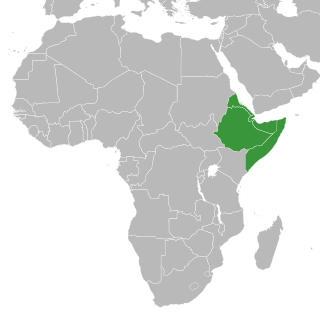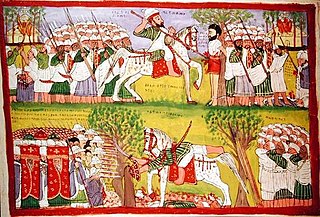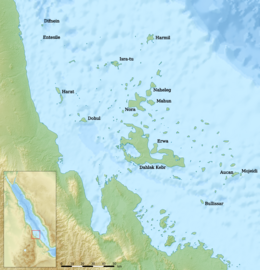
Massawa or Mitsiwa is a port city in the Northern Red Sea region of Eritrea, located on the Red Sea at the northern end of the Gulf of Zula beside the Dahlak Archipelago. It has been a historically important port for many centuries. Massawa has been ruled or occupied by a succession of polities during its history, including the Kingdom of Aksum, the Ethiopian Empire, the Ottoman Empire and the Kingdom of Italy.

The Adal Sultanate also known as the Adal Empire, or Bar Saʿad dīn was a medieval Sunni Muslim Empire which was located in the Horn of Africa. It was founded by Sabr ad-Din III on the Harar plateau in Adal after the fall of the Sultanate of Ifat. The kingdom flourished c. 1415 to 1577. At its height, the polity under Sultan Badlay controlled the territory stretching from Cape Guardafui in Somalia to the port city of Suakin in Sudan. The Adal Empire maintained a robust commercial and political relationship with the Ottoman Empire. Sultanate of Adal was alternatively known as the federation of Zeila.

Dahlak Kebir is the largest island of the Dahlak Archipelago. Situated in the Red Sea off of the coast of Eritrea, it was formerly called Dahlak Deset.

The Buri Peninsula extends from central Eritrea north into the Red Sea.

Dahalik is an endangered Afroasiatic language spoken exclusively in the Dahlak Archipelago in Eritrea. Its speech area is off the coast of Massawa, on three islands in the Dahlak Archipelago: Dahlak Kebir, Nora, and Dehil.
Yeshaq was the Bahr Negus during the mid to late 16th century. A subordinate of Ethiopian Emperor Dawit II, he was noted for supporting Gelawdewos during the Ethiopian-Adal war, and rebelling against his successors.

Habesh Eyalet was an Ottoman eyalet. It was also known as the Eyalet of Jeddah and Habesh, as Jeddah was its chief town, and Habesh and Hejaz. It extended on the areas of coastal Hejaz and Northeast Africa that border the Red Sea basin. On the Northeast Africa littoral, the eyalet comprised Suakin and their hinterlands.

Conflicts in the Horn of Africa have been occurring since the 17th century BCE. The Horn of Africa includes the nations of Djibouti, Eritrea, Ethiopia, and Somalia.

The Ethiopian Empire, also formerly known by the exonym Abyssinia, or simply known as Ethiopia, was a sovereign state that historically encompasses the geographical area of present-day Ethiopia and Eritrea from the establishment of the Solomonic dynasty by Yekuno Amlak approximately in 1270 until the 1974 coup d'etat by the Derg, which dethroned Emperor Haile Selassie. By 1896, the empire incorporated other regions such as Hararghe, Gurage and Wolayita, and saw its largest expansion with the federation of Eritrea in 1952. Throughout much of its existence, it was surrounded by hostile forces in the African Horn; however, it managed to develop and preserve a kingdom based on its ancient form of Christianity.

The Ethiopian–Adal War or Abyssinian–Adal War, also known in Arabic as the "Futuḥ al-Ḥabash", was a military conflict between the Christian Ethiopian Empire and the Muslim Adal Sultanate from 1529 to 1543. The Christian Ethiopian troops consisted of the Amhara, Tigrayans, Tigrinya and Agaw people, and at the closing of the war, supported by a few hundred Portuguese musketmen. Whereas Adal forces were mainly composed of Harla, Somali, Afar, as well as Arab and Turkish gunmen. Both sides at times would see the Maya mercenaries join their ranks.

The Ottoman-Portuguese conflicts were a period of conflict during the Ottoman–Portuguese confrontations and series of armed military encounters between the Portuguese Empire and the Ottoman Empire along with regional allies in and along the Indian Ocean, Persian Gulf, and Red Sea.
Dahlak Subregion is a subregion in the Northern Red Sea region of Eritrea. It is the administrative subregion that covers the islands of the Dahlak Archipelago. The capital lies at Jimhil.

The Khedivate of Egypt was an autonomous tributary state of the Ottoman Empire, established and ruled by the Muhammad Ali Dynasty following the defeat and expulsion of Napoleon Bonaparte's forces which brought an end to the short-lived French occupation of Lower Egypt. The Khedivate of Egypt had also expanded to control present-day Sudan, South Sudan, Eritrea, Djibouti, northwestern Somalia, northeastern Ethiopia, Lebanon, Jordan, Syria, Greece, Cyprus, southern and central Turkey, in addition to parts from Libya, Chad, Central African Republic, Democratic Republic of Congo, and Uganda, as well as northwestern Saudi Arabia, parts of Yemen and the Kingdom of Hejaz.
Mereb Melash, also known as Midri Bahr, Ma'ikele Bahr or Bahr Melash was a semi-autonomous province located north of the Mareb River, in the Eritrean highlands (Kebassa) and some surrounding areas. Mereb Melash corresponds to the administrative territory ruled by the Bahr Negash in medieval times. Mereb Melash comprised the historical provinces of Hamasien and Seraye.

The Ottoman Empire conquered the Habesh starting in 1557, when Özdemir Pasha took the port city of Massawa and the adjacent city of Arqiqo, even taking Debarwa, then capital of the local ruler Bahr negus Yeshaq. They administered this area as the province of Habesh. Yeshaq sought the assistance of emperor Gelawdewos, reinforced by a large Abyssinian army, he recaptured Debarwa, taking all the gold the invaders had piled within. In 1560 Yeshaq, disillusioned with the new Emperor of Ethiopia, revolted with Ottoman support but pledged his support again with the crowning of Emperor Sarsa Dengel. However, not long after, Yeshaq revolted once again with Ottoman support but was defeated once and for all, leaving the Ottomans with domain over Massawa, Arqiqo, and some of the nearby coastal environs, which were soon transferred to the control of Beja Na'ibs (deputies).

The Sultanate of Dahlak was a small medieval kingdom covering the Dahlak Archipelago and parts of the Eritrean coast. First attested in 1093, it quickly profited from its strategic trading location, gaining heavily from being near to Yemen as well as Egypt and India. After the mid 13th century Dahlak lost its trade monopoly and subsequently started to decline. Both the Ethiopian empire and Yemen tried to enforce their authority over the sultanate. It was eventually annexed by the Ottomans in 1557, who made it part of the Habesh Eyalet.
The Kingdom of Jarin was an early medieval kingdom centered in Northeast Africa. According to Al-Yaqubi, it was one of six Beja kingdoms that existed in the region during the 9th century. The kingdom's territory was located between Gash-Barka and Massawa. The king of Jarin rule extended from Massawa on the Red Sea coast, to the frontier of Gash-Barka having borders with the Baqlin kingdom.It was one of the five Beja kingdoms noted by Al-Yaqubi.
The military history of Djibouti encompasses the major conflicts involving the historic empires and sultanates in the territory of present-day Djibouti, through to modern times. It also covers the martial traditions and hardware employed by Djiboutian armies and their opponents.
Beginning with the Kingdom of Aksum, Ethiopia's territory evolved significantly through conquest of the lands surrounding it. Strong Aksumite trading partnerships with other world powers gave prominence to its territorial expansion. In 330, Aksum besieged the Nubian city of Meroë, marking the beginning of its great expansion. It finally declined after the rise of Islamic dominion in South Arabia, and it ultimately collapsed in the 10th century.

















